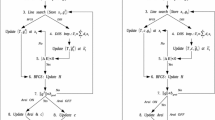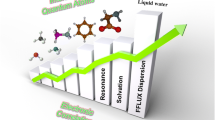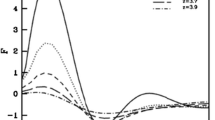Abstract
Localized strongly orthogonal geminals are constructed by using the SCF orbitals of Parr and Mulliken. The best geminal product wave function is taken as zeroth order function and second order correction is calculated by the extended separated pair theory. 101.3 % of the total “horizontal” correlation energy is obtained taking the result of the “full” CI calculation as standard. It is found that the contribution of terms neglected in the conventional separated pair theory is very important. The results are compared with those obtained by other variants of the Rayleigh-Schrödinger perturbation theory. As has been expected the result of the extended separated pair theory is superior to that of other perturbation theories discussed in the paper.
Zusammenfassung
Lokalisierte stark orthogonale Geminale werden aus den SCF-Orbitalen von Parr und Mulliken konstruiert. Die beste Produktwellenfunktion aus Geminalen wird als Näherungsfunktion nullter Ordnung verwendet, und eine Korrektur zweiter Ordnung wird mit Hilfe der erweiterten Theorie der unabhängigen Elektronenpaare berechnet. 101,3% der gesamten „horizontalen“ Korrelationsenergie wird erhalten, wenn man die „volle“ CI-Rechnung als Standard nimmt. Es wird gefunden, daß der Beitrag von Termen, die in der konventionellen Theorie der unabhängigen Elektronenpaare vernachlässigt werden, sehr wichtig ist. Die Resultate werden mit denjenigen anderer Varianten der Rayleigh-Schrödinger Störungstheorie verglichen. Wie erwartet sind die Resultate der erweiterten Theorie der unabhängigen Elektronenpaare besser als diejenigen anderer hier diskutierter Störungstheorien.
Résumé
Des géminales localisées fortement orthogonales sont construites en utilisant les orbitals SCF de Parr et Mulliken. La meilleure fonction d'onde produit de géminales est prise comme fonction d'ordre zéro et la correction du second ordre est calculée par la théorie des paires séparées étendue. Si l'on prend le résultat de l'I.C. «complète» comme référence, on obtient ainsi 101,3% de l'énergie de corrélation «horizontale». On trouve que la contribution des termes négligés dans la théorie des paires traditionnelle est très importante. Les résultats sont comparés à ceux obtenus à l'aide d'autres variantes de la théorie des perturbations de Rayleigh-Schrödinger. Comme il falleit s'y attendre, la théorie des paires séparées étendue donne un résultat supérieur à celui des autres traitements de perturbation.
Similar content being viewed by others
References
Miller, K. J., and K. Ruedenberg: J. chem. Physics 43, S 88 (1965).
Ebbing, D. D., and R. C. Henderson: J. chem. Physics 42, 2225 (1965).
Ahlrichs, R., and W. Kutzelnigg: J. chem. Physics 48, 1819 (1968).
— —: Chem. Physics Letters 1, 651 (1968).
— —: Theoret. chim. Acta (Berl.) 10, 377 (1968).
Kapuy, E.: Theoret. chim. Acta (Berl.) 6, 281 (1966).
Staemmler, V., and W. Kutzelnigg: Theoret. chim. Acta (Berl.) 9, 67 (1967).
Parr, R. G., and R. S. Mulliken: J. chem. Physics 18, 1338 (1950).
Pullman, A.: J. Chim. physique 51, 188 (1954).
Nesbet, R. K.: Proc. Roy. Soc. (London) A 230, 312, 322 (1955).
Møller, C., and M. S. Plesset: Physic. Rev. 46, 618 (1943).
Claverie, P. S., S. Diner, and J. P. Malrieu: Internat. J. Quantum Chem. 1, 751 (1967).
Diner, S., J. P. Malrieu, and P. Claverie: Theoret. chim. Acta (Berl.) 8, 390 (1967).
Malrieu, J. P., P. Claverie, and S. Diner: Theoret. chim. Acta (Berl.) 8, 404 (1967).
Parks, J. M., and R. G. Parr: J. chem. Physics 28, 335 (1958).
Parr, R. G.: Quantum theory of molecular electronic structure. New York: W. A. Benjamin, Inc. 1963.
McWeeny, R.: Proc. Roy. Soc. (London) A 253, 242 (1959).
—: Rev. mod. Physics 32, 335 (1960).
—: Acta Physic. Acad. Sci. Hung. 15, 147 (1962).
—: Physics Letters 1, 205 (1962).
—: Acta Physic. Acad. Sci. Hung. 12, 351 (1960).
Lycos, P. G., and R. G. Parr: J. chem. Physics 24, 1166 (1956).
Author information
Authors and Affiliations
Rights and permissions
About this article
Cite this article
Kapuy, E. Application of the extended separated pair theory to the π-electrons of trans-butadiene without zero differential overlap approximation. Theoret. Chim. Acta 12, 397–404 (1968). https://doi.org/10.1007/BF00525917
Received:
Issue Date:
DOI: https://doi.org/10.1007/BF00525917




